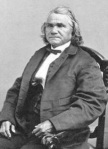Most of us from the “baby boom” generation and older recognize and connect the name William T. Sherman to four years of conflict between northern and southern states of this Republic (1861-1865).
Sherman entered the U.S. Military Academy at West Point when he was 16 years old and graduated four years later (in 1840). While at West Point, he never rose above the rank of Private; according to Sherman’s memoirs, he received an average of 150 demerits annually.
Thanks to the influence of his foster father, Thomas Ewing (an Ohio lawyer and politician), Sherman ranked as a second lieutenant in his initial years’ service with the Army. While Ewing served as Secretary of the Department of the Interior (1849-1850), Sherman married his daughter and was duly promoted to the rank of Captain. Three years later, he resigned his captaincy and went to work for a St. Louis-based bank. Sherman was hired in 1859 as superintendent of the Louisiana State Seminary of Learning & Military Academy (later re-named Louisiana State University).
Although he was pro-slavery, Sherman was against fracturing of the Union. When Louisiana joined the Confederacy, he resigned from the Seminary and moved to St. Louis. In May 1861, his brother, John Sherman, a U.S. Senator (Ohio), helped him acquire a commission as Colonel in the Army’s 13th U.S. Infantry. After the Union’s defeat at Bull Run two months later, President Lincoln promoted Sherman to Brigadier General. After three months, Sherman took over command of the military’s Department of the Cumberland (Louisville, Kentucky). But promptly and at his own request, Sherman was relieved of that duty and transferred to the Department of the Missouri (St. Louis). Less than two months later, Major General Henry Halleck, Commander of the Department of the Missouri, determined Sherman to be unfit for duty and placed him on leave.
By mid-December 1861, Sherman returned to his duties under Halleck for the Department of the Missouri. Sherman was reassigned to Brigadier General Ulysses S. Grant’s command (District of West Tennessee) the following March and placed as commander of the 5th Division, Army of West Tennessee. The Shiloh battle took place in April 1862 after which Sherman was promoted to Major General of Volunteers, then military governor of Union-occupied Memphis, Tennessee.
By spring of 1864, Sherman was promoted to command of the Military Division of the Mississippi, and Grant took the overall command of Union armies. Emboldened, Sherman invaded the state of Georgia with close to one hundred thousand troops. Before arriving in Atlanta, he received a commission as major-general in the regular Army. Citizens of union-occupied Atlanta were ordered out of the city while Sherman burned all the military and government buildings and much of the city’s private residences.
Following Lincoln’s election as President, Sherman took sixty-two thousand troops and began another march through Georgia to the port at Savannah. As seen in his field reports, Sherman and his men took everything they saw and wanted causing estimated property damage in excess of $100 million. The 25 December 1864 New-York Times published Sherman’s jubilant message to President Lincoln:
Savannah, Ga., Dec. 22.
To His Excellency, President Lincoln: I beg to present you as a Christmas gift, the city of Savannah, with one hundred and fifty heavy guns and plenty of ammunition, and also about twenty-five thousand bales of cotton.
(Signed.) W. T. Sherman, Major-General
Sherman then proceeded north, decimating South Carolina and North Carolina along the way. On 9 April 1865, General Robert E. Lee, Commander of the Confederate Army, surrendered to General Grant, Commander of the Union Army. Then on 26 April 1865, the commander of Confederate troops in the Carolinas, General Joseph E. Johnston, surrendered to General Sherman who had just trounced those two states.
On 9 May 1865, U.S. President Andrew Johnson declared an end to the war.
On 23 June 1865 near Doaksville, Choctaw Nation, Union representatives met with Brigadier General Stand Watie, comander of the Confederate Indian Cavalry, Army of the Trans-Mississippi. Watie signed a cease fire agreement at that time … the last Confederate capitulation.
Throughout his career with the Army, Sherman used the term “hard-war” to describe what he perceived as the appropriate reality and justification for his actions during conflicts in which he was involved. His ideology was in view not only during the conflict between the states, but also during efforts by the U.S. government and military to eliminate as many red-skinned people as possible, and subjugate and segregate the survivors.
Summer of 1865 found Lieutenant General Sherman in command of the Military Division of the Missouri which included territory between the Rocky Mountains and Mississippi River. His friend, Ulysses S. Grant, had been honored by Congress with the new position as General of the Army.
Shortly after the military’s November 1868 massacre of Black Kettle’s band of Cheyenne camped alongside the Washita River in western Indian Territory, President Grant honored Sherman with appointment as the new General of the Army.
Records of Sherman’s military actions from the civil war through his 1884 retirement are replete at Federal Depository Libraries, other venues of historical collections, digitized primary documents at universities and colleges, digitized newspaper editorials, and more. During research on the 27 November 1868 Washita River massacre, I discovered the following portions of a report written by Lt. General Sherman three weeks later :
“… I am well satisfied with Custer’s attack, and would not have wept if he could have served Satanta’s and Bull Bear’s bands in the same style. I want you all to go ahead, kill and punish the hostile, rescue the captive white women and children, capture and destroy the ponies, lances, carbines, &c., of the Cheyennes, Arapahoes and Kiowas. Mark out the spots where they must stay, and then systematize the whole (friendly and hostile) into camps, with a view to economical support, until we can try and get them to be self-supporting, like the Cherokees and Choctaws. They must clearly understand that they must never again hunt outside the limits of the territory … If the game of the Indian Territory do[es] not suffice for their support, the United States must feed them till they can raise tame cattle, sheep, and hogs …
“The House of Representatives promptly passed the bill transferring the Indian Bureau from the Interior to the War Department; but the bill is held in committee of the Senate. I believe still it will pass; but even if it do[es] not, the course I have indicated must be followed before Indian agents can pretend to manage the four bands now construed to be at war, viz: Cheyennes, Arapahoes, Kiowas and Comanches. I believe that Generals Sheridan and Hazen will, when they meet at Fort Cobb, fully accomplish this, but I would like that Bull Bear and Satanta should be killed before the tribes are allowed any favors at our hands …”
NOTES: The U.S. Senate did not concur on transferring the Indian Bureau back to the War Department; it wisely remained part of the Department of the Interior. The truth of what happened before, during, and after the unprovoked massacre of Black Kettle and his band on the Washita River was later confirmed by Congressional and federal authorities, upholding the claims by men such as Thomas Murphy and Edward Wynkoop. (See article below entitled “From the horses’ mouths: Washita River Massacre.)
~ ~ ~ ~ ~ ~ ~ ~
SOURCE: W. T. Sherman, Lieutenant General, Headquarters Military Division of the Missouri, St. Louis, Missouri, 23 December 1868, to Major General P. H. Sheridan, Commanding Officer, Fort Gibson, Cherokee Nation, in Executive Documents printed by order of the House of Representatives during the Second Session of the Forty-First Congress 1869-1870, Volume #3, Serial Set 1425, pp. 177-178, Washington, D.C.: Government Printing Office, 1870.





